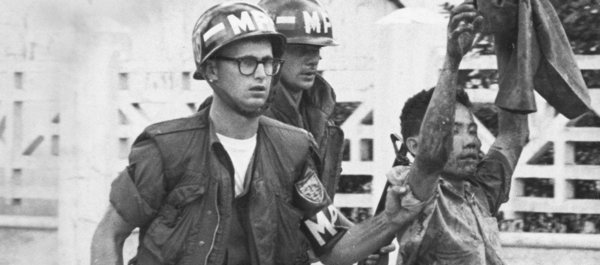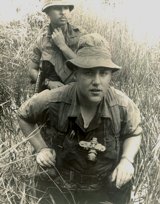
From the February 2012 issue of Vietnam magazine.
The previous day had been peaceful, other than the never-ending firecrackers that marked the Vietnamese Lunar New Year, Tet. But that was yesterday. Now, it was early on the morning of January 31, 1968, and Saigon was in flames. As I walked down the street near the U.S. Embassy, I began shooting pictures, still trying to process the fact that there were battles raging across South Vietnam’s capital city.
Getting to that spot at the right time to snap that photo was a stroke of luck in more ways than one.
The friendly crackle of celebratory firecrackers had been replaced with menacing bursts of Viet Cong AK-47s in the streets of Saigon and throughout the rest of the country. What would soon become known to history as the Tet Offensive was in full swing and the new U.S. Embassy in Saigon was at the epicenter.
In the early morning light as I walked to the white, walled building that represented American power and prestige, a pair of military policemen from the 716th Military Police Battalion hustled toward me. Corporal George Moyer and Spc. 4 James Singer were marching a blood-splattered Vietnamese away from the embassy. Their captive, clad only in shorts and a bloodstained shirt, was one of the surviving Viet Cong sappers who had attacked the embassy compound early that morning. While they were unable to seize the embassy, they did inflict a crippling wound to the American psyche, one that reverberates to this day.
The light was still tricky, and as I raised my personal Pentax camera, I remember thinking to myself: “This could be good. I really hope the picture comes out.”
It did, and that shot ran in military and civilian newspapers and magazines in the immediate aftermath of Tet and for years after, and has graced the cover of at least two books. Those few seconds proved to be life changing for me because that photo—and others that I shot that day at the embassy—ultimately led to a post-service job offer as a Vietnam war correspondent with the Overseas Weekly newspaper, at the princely starting pay of $100 a week and no life insurance. I jumped at it, of course, and never regretted it, as it was a springboard for a journalism career that lasted more than 40 years.
But that photograph of the sapper was almost never taken. Getting to that spot at the right time was a stroke of luck in more ways than one. In fact, I shot the photo during what was my second trip to the embassy that day. I almost didn’t survive the first one.
My job, MOS 84B, was still photographer. I’d finagled a transfer from an up-country unit, the 54th Signal Battalion, to Saigon because the 54th’s photo section spent more time pulling maintenance on jeeps than actually getting out to the field to photograph the war. I had volunteered in 1967 for a second Vietnam tour in the hopes of somehow breaking into the civilian news business, and jeep maintenance didn’t seem the way to do it. I figured that if I couldn’t be famous, I might as well be comfortable and safe. Besides, Saigon had a lot of civilian media, and maybe I would get lucky.
It turned out that getting to the Headquarters Area Command (HAC) Public Affairs Office was as simple as calling up Master Sgt. Henry Rice, a World War II combat vet who had an 82nd Airborne Division patch on his right shoulder and multiple small stars on his jump wings, each star indicating a combat jump. Sergeant Rice and I had worked together when we were stationed in Berlin in 1966-67, and through his NCO network he was able to have me reassigned to his office in Saigon in late 1967.
Early on the morning of January 31, we left the Plaza Hotel, which was serving as a military billet near Saigon’s Central Market, for the public affairs office. Rumors were flying among the troops milling around the hotel lobby of a lot of trouble in the city and at the embassy. In an excited voice I said something like: “Sergeant Rice! Sergeant Rice! I heard the embassy is being attacked!”
In his most crusty NCO manner, he replied: “Hirst, you’re always exaggerating. We’re going to drive by the embassy and I’ll show you that nothing is going on.”
So we piled into our International Harvester Scout vehicle, with Staff Sgt. Larry Clayton at the wheel, Rice riding shotgun and me in the back seat, and headed toward the embassy.
As we neared, it was obvious that a lot was going on.
In a number of the post-attack photos of the chancery, four big black splotches where Viet Cong rockets hit the building can be seen. To this day, I can still vividly recall the impact, smoke and fire as one of those rockets soared past us and crashed into the building as we pulled up in front. Time seemed to go into slow motion as it always does in situations like that.
“Clayton!” Rice growled. “Get us the hell out of here!”
I never did hear any more from Rice about my exaggerating.
 At that time, we were unarmed—me doubly so. Our weapons were at the arms room at the HAC headquarters miles away, near Tan Son Nhut Airbase. My cameras—a government-issued one and my own Pentax—were in the Public Affairs Office in the Tax Building in central Saigon.
At that time, we were unarmed—me doubly so. Our weapons were at the arms room at the HAC headquarters miles away, near Tan Son Nhut Airbase. My cameras—a government-issued one and my own Pentax—were in the Public Affairs Office in the Tax Building in central Saigon.
A short time later, with my Pentax but still without my M-14, I was back near the embassy. But my boss, HAC public affairs officer Major Malcom Wollard, had given me a most unwelcome assignment. My mission was to simply play gatekeeper, checking the press credentials of journalists who wanted to get past a checkpoint that had been set up about a block away from the embassy. So close and yet so far. I might as well be doing jeep maintenance at my old unit.
Figuring it was better to ask for forgiveness later, I dutifully checked a press credential or two and then said the hell with it and headed toward the action at the embassy.
That was when I saw Moyer and Singer leading their bloodied captive away. After shooting several frames of that, I continued into the embassy grounds, taking more pictures as I moved from place to place. When I figured I had enough photos, I hightailed it back to the small darkroom in our office to develop the film and then start making prints. In no time, finished photos were available for distribution to the media. A set of enlargements went to the Armed Forces Vietnam Network and they were shown on the television newscast that evening. My thrill at seeing my pictures appearing on television screens throughout South Vietnam was dampened somewhat when the news anchor, in the finest tradition of broadcast journalism, said that the pictures “were taken by Specialist Herp of the USAHAC Information Office.”
“It’s Hirst, not Herp,” I muttered angrily at the TV set.
I felt a bit cheated by that, but my morale shot into orbit a few days later when the MACV Observer, the official paper for all the services, and the USARV Reporter, the official in-country paper for the U.S. Army Vietnam, ran the captured-sapper shot on their front pages, along with a number of other photos I’d taken at the embassy that day. The photo credit, “By Sp5 Donald A. Hirst,” was prominently displayed with each photo.
Feeling on top of the world when the papers hit the streets a few days later, I got on the Public Affairs Office phone and called the photo lab at my old unit. The photographers I’d once worked with there had seen the pictures, and there were lots of congratulations. “You’re on your way! You made it!” my colleagues said.
After a few minutes of that, I realized I hadn’t yet talked with my closest buddy, Spc. 4 Marcello Lofaro. “Hey, where’s Mark?” I asked. “Get him on the phone.”
My query was met with a lengthy pause on the other end, until finally, someone uttered: “Mark’s dead. He got killed taking pictures the night before Tet.”
In an instant, my triumph turned into ashes. Stunned and shaken to the core, I muttered something or the other in a choked, hushed voice. Then, blinking back the tears, I hung up. Four decades later, I still lose it when I try to tell that story. I was later able to piece together what had happened to my friend. In some parts of the country, the Viet Cong had jumped the gun, launching the Tet Offensive a day earlier, on January 30. Nha Trang was one of those places.
Mark and I often talked about our shared dream of making it into the news business after the Army. So when the fighting erupted that night, he grabbed his camera and went to work like I did, looking for that one shot that might open the door to his dream of being a professional photojournalist. Shot in the head, my friend Mark was killed instantly.
Mark’s name, of course, is on the Vietnam Memorial, on the Wall’s Panel 35E, Row 74. He’s also honored at the Defense Information School at Fort Meade, Md., where new generations of military journalists and photographers are trained. They have a Hall of Heroes, where small plaques bear the names, ranks, services, and dates and places of death of those military journalists who died in the line of duty.
Tet has always been a very mixed bag for me. Heady triumph and indelible pain, mingled together and impossible to separate. On the one hand it was when I shot that memorable picture that opened up a whole new world to me. But it’s also when a good friend became 20 years old forever.
Don Hirst served two extended Army tours in Vietnam and then returned as a civilian photographer and reporter with the Overseas Weekly from 1968 to 1972. He later was an associate editor with Army Times in Washington, D.C., for more than 11 years and then went on to launch the magazine Salute, serving as its executive editor for nearly two decades.




